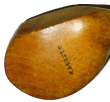
|
Registration Edit profile catalogue auction shopping cart shipping history makers search faq news links about contact |

Clubmakers
James Ockenden
London
 James Ockenden was born in Epsom in 1885 and his first professional appointment was at Greatstone in 1906 before moving to become professional at Wembley between 1909 and 1914 at which time he went to West Drayton. It was from here he had his best finish in the Open Championship, finishing 7rh in 1914. He enlisted in the Royal Garrison Artillery in 1916 and served in France. A quarter of the members had gone to war by this time and others had left the club due to the associated economic hardships so West Drayton had to close. On his return from the army James Ockenden took up the post of professional at Raynes Park.
James Ockenden was born in Epsom in 1885 and his first professional appointment was at Greatstone in 1906 before moving to become professional at Wembley between 1909 and 1914 at which time he went to West Drayton. It was from here he had his best finish in the Open Championship, finishing 7rh in 1914. He enlisted in the Royal Garrison Artillery in 1916 and served in France. A quarter of the members had gone to war by this time and others had left the club due to the associated economic hardships so West Drayton had to close. On his return from the army James Ockenden took up the post of professional at Raynes Park.1920 brought him some success in the News of the World where he defeated both James Braid and George Duncan which ‘no one outside a lunatic asylum would have had the audacity to imagine’ according to Golf Illustrated, before falling to the eventual winner, Abe Mitchell.
In 1921 he took part in the pre-pre-Ryder Cup (see article on Gleneagles in the History section) where 12 golfers representing each nation played one another prior to the matchplay competition of the Thousand Guineas Golf Tournament.
His form in major tournaments was frustrating ‘a consistent runner-up in big events’, said one newspaper report, ‘has not been rewarded in accordance with his merits’, wrote The Times in 1922 and, when he finally won the French Open in 1923, the Aberdeen Journal noted that he ‘has at times beaten most of the leading British golfers and the title he now wears is his due’. It was a fine victory, he trailed Jean Gassiat by five strokes at the end of the third round but was ten strokes better in the final round.
This triumph made a tour of the United States with Arthur Havers, the Open Champion, possible and they spent four months playing exhibition matches, including 72 holes against Hagen and Sarazen in San Francisco and Los Angeles, and the North and South Open at Pinehurst. Ockenden apparently turned down several offers of employment while in the USA.
Seemingly a conservative in golfing matters he wrote in 1923 calling for a return to only smooth-faced irons for professional tournament play to prevent unfair advantages accruing from club design.
Raynes Park, like West Drayton, was also forced to close, sold for housing land in 1925, and James moved first to Hanger Hill and then North Middlesex. In 1948 he emigrated to South Africa to join his son who had forged a successful career as a golf professional there but returned to England having had a leg amputated. He died shortly after his return in 1949.
![]() Search the catalogue for
clubs by this maker
Search the catalogue for
clubs by this maker
site design dmc ltd | © 2000-2024 Antique Golf Clubs from Scotland